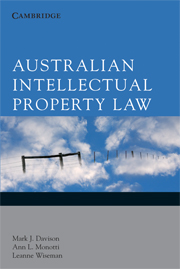Book contents
- Frontmatter
- Contents
- Preface
- Acknowledgements
- Table of statutes
- Table of cases
- 1 Introduction
- 2 Passing off
- 3 Registered trade marks
- 4 Exploitation of registered trade marks
- 5 Copyright: Introduction
- 6 Subsistence of copyright
- 7 Authorship and first ownership, nature of the rights and duration
- 8 Exploitation, infringement and defences
- 9 Moral rights, performers' rights and circuit layouts
- 10 Designs
- 11 Equitable doctrine of breach of confidence
- 12 Patents for inventions: introduction
- 13 Patents for inventions: validity
- 14 Patents for inventions: allocation of rights and ownership, the Register and dealings
- 15 Patents for inventions: exploitation, infringement and revocation
- 16 Plant breeder's rights
- 17 Remedies and miscellaneous issues
- Appendix
- Index
Appendix
- Frontmatter
- Contents
- Preface
- Acknowledgements
- Table of statutes
- Table of cases
- 1 Introduction
- 2 Passing off
- 3 Registered trade marks
- 4 Exploitation of registered trade marks
- 5 Copyright: Introduction
- 6 Subsistence of copyright
- 7 Authorship and first ownership, nature of the rights and duration
- 8 Exploitation, infringement and defences
- 9 Moral rights, performers' rights and circuit layouts
- 10 Designs
- 11 Equitable doctrine of breach of confidence
- 12 Patents for inventions: introduction
- 13 Patents for inventions: validity
- 14 Patents for inventions: allocation of rights and ownership, the Register and dealings
- 15 Patents for inventions: exploitation, infringement and revocation
- 16 Plant breeder's rights
- 17 Remedies and miscellaneous issues
- Appendix
- Index
Summary
Cadbury Schweppes Pty Ltd v Darrell Lea Chocolate Shops Pty Ltd [2007] FCAFC 70
In this case, Cadbury argued that its chocolate was exclusively associated with the colour purple and objected to the use of that colour on chocolates by Darrell Lea. At first instance, the trial rejected the existence of an exclusive association between Cadbury and purple. The trial judge also ruled inadmissible some expert evidence that Cadbury sought to adduce on this point. The appeal decision turned on the trial judge's decision to exclude the expert testimony, which expressed an opinion as to the nature and extent of the association of purple with Cadbury. After consideration of the effect of ss 79 and 135 of the Evidence Act 1995 (Cth), the Full Court decided to order a re-trial in which the originally excluded evidence would be admitted.
Woolworths Ltd v BP (No 2) [2006] FCAFC 132
Woolworths objected to the registration by BP of ‘the colour Green as shown in the representation on the application applied as the predominant colour to the fascias of buildings, petrol pumps, signage boards – including poster boards, pole signs and price boards – and spreaders, all used in service station complexes for sale of the goods and supply of the services covered by the registration’.
The trial judge found significant evidence of use of the colour green by BP in its get-up and advertising. On that basis, he found that the applicant's trade mark had acquired distinctiveness through use pursuant to s 41(6).
Information
- Type
- Chapter
- Information
- Australian Intellectual Property Law , pp. 610 - 612Publisher: Cambridge University PressPrint publication year: 2008
